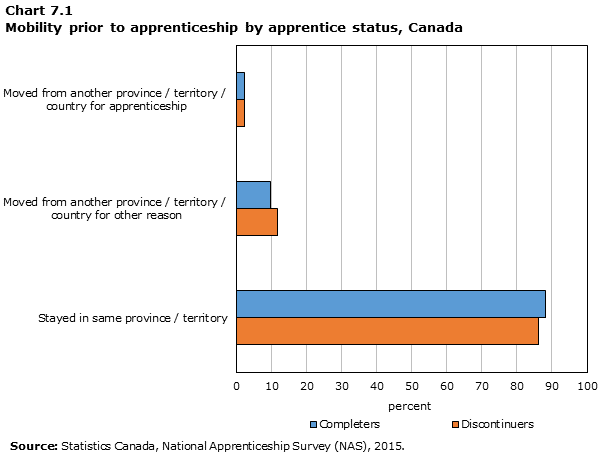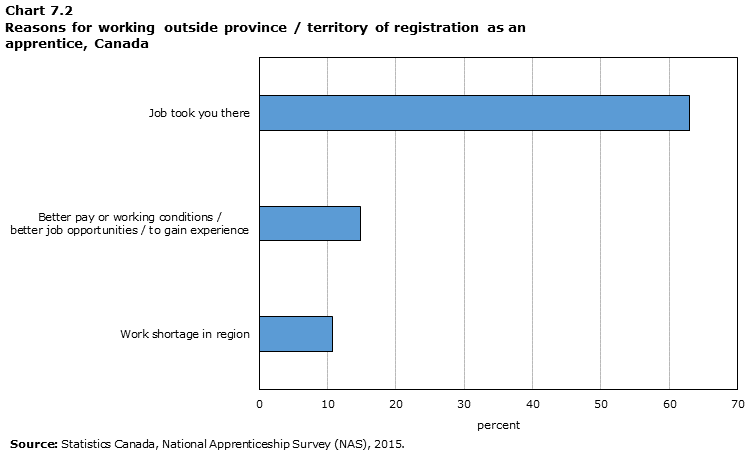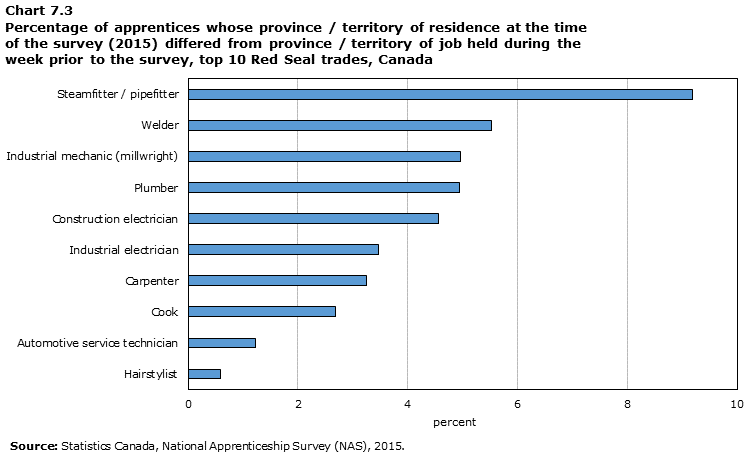National Apprenticeship Survey: Canada Overview Report 2015
Section 7 Mobility
Archived Content
Information identified as archived is provided for reference, research or recordkeeping purposes. It is not subject to the Government of Canada Web Standards and has not been altered or updated since it was archived. Please "contact us" to request a format other than those available.
It is widely understood that employment prospects in the trades depend on labour market demand across provinces and territories. Apprentices, therefore, can increase their job opportunities when a program allows them to move across jurisdictions.
This section summarizes data from the 2015 NAS on the mobility of apprentices before, during and after an apprenticeship program, whether they received credit for their training and the province or territory of their subsequent employment. Throughout the analysis, data are presented for such groups as completers, discontinuers and apprentices in the top 10 Red Seal trades.
Key findings
- More than 1 in 10 apprentices moved from a province, territory or country of residence prior to an apprenticeship.
- About 7% of apprentices had worked outside their provinces or territories as apprentices and the majority of them stated that their jobs took them there. Among this group, a higher percentage of completers than discontinuers received credit for hours worked outside the province or territory (84.0% versus 69.0%) of their apprenticeships.
- At the time of survey, completers were less likely than discontinuers to be residing in a different province or territory as their provinces or territories of registration (5.0% versus 8.7%).
- A higher percentage of completers than discontinuers received credit for hours worked outside their provinces or territories (84.0% versus 69.0%).
- Apprentices in the steamfitter / pipefitter and welder trades were among the more mobile apprentices across the top 10 Red Seal trades.
- Nearly 4% of apprentices held a job during the week prior to the survey in a province or territory that differed from a province or territory of residence at the time of the survey. Of these apprentices, half worked in Alberta (50.8%).
Mobility before an apprenticeship
Apprentices in the 2015 NAS were asked whether they had moved from another province, territory, or country prior to starting an apprenticeship. They were also asked whether their moves were specifically for the purpose of an apprenticeship program. A total of 12.8% of apprentices had moved from a province or territory of residence, or from another country to Canada, in the 12 months prior to an apprenticeship (Table A.7.1, Appendix A). Only about 1 in 6 movers had changed a location specifically for an apprenticeship.
Chart 7.1, below, shows that there was no significant difference between the proportion of completers and discontinuers who moved for an apprenticeship program (2.3% and 2.2%, respectively) (refer to Table A.7.1, Appendix A for detailed results). However, discontinuers (11.7%) were more likely than completers (9.6%) to have moved from another province, territory or country for a reason other than an apprenticeship program.

Data table for Chart 7.1
| Discontinuers | Completers | |
|---|---|---|
| percent | ||
| Stayed in same province / territory | 86.1 | 88.0 |
| Moved from another province / territory / country for other reason | 11.7 | 9.6 |
| Moved from another province / territory / country for apprenticeship | 2.2 | 2.3 |
| Source: Statistics Canada, National Apprenticeship Survey (NAS), 2015. | ||
Mobility during an apprenticeship
Apprentices in the 2015 NAS reported information about their mobility throughout an apprenticeship program and indicated the reasons why they had moved to another province or territory. Apprentices also reported whether their work hours and course work were recognized in another province. These data are presented in Table A.7.2 (Appendix A).
Completers and discontinuers who had some work experience in a trade during an apprenticeship were asked whether they had worked as apprentices outside their provinces or territories of registration. About 7% of apprentices reported they had worked in another province or territory during this time (Table A.7.2, Appendix A). The results also indicate that there was no significant difference between the proportion of completers (7.7%) and the proportion of discontinuers (6.7%) who worked as apprentices outside their provinces or territories of registration.
NAS apprentices who had worked outside their provinces or territories as apprentices were asked to indicate a reason why they had done so. These results are presented by apprentice status in Table A.7.2 (Appendix A) and Chart 7.2, below. The majority of respondents stated that their jobs took them to another province or territory (62.9%), while 14.8% left for “better pay or working conditions / better job opportunities / to gain more experience.” One in 10 of these apprentices worked in another province or territory because there was a shortage of work in a region.
Apprentices who worked in another province or territory were also asked whether the hours they worked were credited toward an apprenticeship. Of these, 78.7% reported that their work hours did count toward their apprenticeship hours. However, there was a difference between completers and discontinuers in this regard (Table A.7.2, Appendix A). While the majority of completers (84.0%) reported that their hours were credited toward an apprenticeship, only 69.0% of discontinuers had their hours recognized.
Apprentices who had some work experience in a trade as apprentices, worked outside their provinces or territories during an apprenticeship, and were registered as apprentices in more than one province were also asked whether they had been able to transfer their work hours or course work when they moved to another province. More than three quarters (76.4%) of these apprentices reported that they had been able to transfer work experience or course work (see detailed results in Table A.7.2, Appendix A). Similar proportions of completers and discontinuers had their hours or course work recognized by another province.

Data table for Chart 7.2
| Percent | |
|---|---|
| Work shortage in region | 10.7 |
| Better pay or working conditions / better job opportunities / to gain experience |
14.8 |
| Job took you there | 62.9 |
| Source: Statistics Canada, National Apprenticeship Survey (NAS), 2015. | |
Mobility and employment after an apprenticeship program
Apprentices reported information about their mobility between a province or territory of registration, a province or territory of residence at the time of the survey (2015)Note 1, and a province or territory of employment (job held in the week prior to their NAS interview). These results are reported in Table A.7.3 (Appendix A).
At the time of the survey, 6.6% of apprentices were residing in a province or territory different than the one reported at registration. This was the case for 8.7% of discontinuers and 5.0% of completers.
Of the total number of apprentices surveyed, 8% of apprentices had worked in the previous week in a province or territory other than their province or territory of registration. Discontinuers were more likely to be movers than were completers (10.4% and 6.4%, respectively).Note 2
The 2015 NAS also allows access to information on apprentices’ movement for work reasons by comparing the apprentices’ province or territory of residence at the time of the survey (2015) and the province or territory of their jobs in the week prior to the time of the survey.Note 3 Nearly 4% of apprentices (3.8%) had worked in a province or territory during the week prior to the time of the survey that differed from a province or territory of residence at the time they were surveyed (Table A.7.3, Appendix A). There was no significant difference in this type of mobility between completers (4.0%) and discontinuers (3.6%).
Nova Scotia (14.2%) and New Brunswick (11.1%) had the highest rates of apprentices residing in these provinces while working in another province or territory during the week prior to the survey (Table A.7.4, Appendix A). Furthermore, 6.4% of apprentices residing in Saskatchewan and 5.9% of apprentices residing in British Columbia were in the same situation. Of those apprentices residing and working in different provinces or territories, about half worked in Alberta (50.8%), and 13.2% in Ontario (Table A.7.5, Appendix A).
Mobility by Red Seal trade
The Red Seal Program was established in the 1950s to facilitate labour mobility for certified journeypersons. It was developed to promote an efficient and integrated national labour market by providing a common foundation for trade certification and apprenticeship training in Canada. The Red Seal Program also aims to harmonize provincial / territorial processes and requirements for skilled trades training, certification and standards. It is based on interprovincial occupational standards and examinations developed by the Canadian Council of Directors of Apprenticeship (CCDA), provinces / territories and industry partners. The Red Seal is the Canadian standard for skilled trades, and is widely recognized and respected by industry across Canada. Certified journeypersons with a Red Seal trade endorsement can work anywhere in Canada where their trades are designated without having to write additional examinations. Given the relevance of interprovincial mobility to these trades, this section examines the mobility of apprentices by Red Seal trade status, focusing on the top 10 Red Seal trades.
Detailed results of apprentices’ mobility by Red Seal trade status are presented in Table A.7.6 (Appendix A). Apprentices in Red Seal trades were more likely than those in non-Red Seal trades to reside in a different province or territory at the time of survey than their province or territory of registration (6.9% and 5.2%, respectively).
Apprentices in the Red Seal trades were also more likely than apprentices in non-Red Seal trades to reside, at the time of the interview, in a province or territory other than their province or territory of work during the week prior to the survey (4.1% and 2.9%, respectively).
Across the top 10 Red Seal trades, at least 5% of apprentices in most trades resided in a province or territory at the time of survey other than their provinces or territories of registration (Table A.7.7, Appendix A). Industrial electrician apprentices, 3.5% of whom had resided in a different province or territory, were the only exception. Notably, more than 1 in 10 steamfitter / pipefitter apprentices (11.1%) and 9.2% of cook apprentices had resided in a province or territory at the time of survey that was not their provinces or territories of registration. Apprentices in the welder trade (7.7%) were also among the more mobile apprentices among these trades.
Across the top 10 Red Seal trades, there was some variation in the mobility of apprentices between their provinces or territories of residence at the time of the survey and those of their jobs in the week prior to the time of the survey. These results are reported in Table A.7.7 (Appendix A) and Chart 7.3, below. Apprentices in the steamfitter / pipefitter trade (9.2%) had the largest proportion of apprentices working in a province or territory that differed from their provinces or territories of residence at the time of the survey. About 5% each of welder (5.5%), industrial mechanic (5.0%), and plumber (4.9%) apprentices resided in a province or territory other than the province or territory of their jobs during the week prior to the survey. However, relatively low proportions of cook (2.7%), automotive service technician (1.2%) and hairstylist (0.6%) apprentices worked and resided in different provinces or territories.

Data table for Chart 7.3
| Percent | |
|---|---|
| Hairstylist | 0.6 |
| Automotive service technician | 1.2 |
| Cook | 2.7 |
| Carpenter | 3.2 |
| Industrial electrician | 3.5 |
| Construction electrician | 4.6 |
| Plumber | 4.9 |
| Industrial mechanic (millwright) | 5.0 |
| Welder | 5.5 |
| Steamfitter / pipefitter | 9.2 |
| Source: Statistics Canada, National Apprenticeship Survey (NAS), 2015. | |
Notes
- Date modified:
